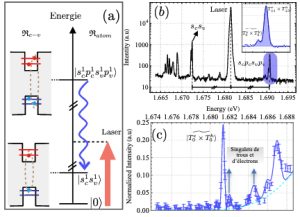A new spectroscopy to unravel spin states in GaAs/AlAs quantum dots
 The on-demand generation of entangled photons is an essential achievement leading to important applications for quantum technologies. In semiconductor quantum dots (QDs), the radiative biexciton-exciton cascade is successfully employed. Resonant two-photon excitation (TPE), coherently preparing the biexcitonic state, significantly improves the entangled photon-pairs emission rate.
The on-demand generation of entangled photons is an essential achievement leading to important applications for quantum technologies. In semiconductor quantum dots (QDs), the radiative biexciton-exciton cascade is successfully employed. Resonant two-photon excitation (TPE), coherently preparing the biexcitonic state, significantly improves the entangled photon-pairs emission rate.
Members of INSP have found a novel use of this technique (TPE) to resonantly probe the spin properties of excited biexcitonic states – impossible to be detected by more conventional techniques – where the two electron-hole (e-h) pairs occupy distinct orbital levels.
Caption
(a) Level diagram representing the resonant 2-photon excitation between the exciton and the biexciton. Both “conduction-valence” Rc-vand “atomic” notation Ratom. are used to represent these quasi-particles to improve clarity.
(b) Luminescence spectrum showing the experimental implementation of the resonant 2-photon excitation. The insert magnifies the luminescence from the pc-pv excited levels, where the doublet appears.
(c) Luminescence intensity of one of the triplet states as a function of the laser energy.
Reference
“Unveiling the spin-singlet states of two electron-hole pair complexes using two-photon excitation in a GaAs/AlAs quantum dot”
S. Germanis, P. Atkinson, A. Bach, R. Hostein, R. Braive, M. Vabre, F. Margaillan, M. Bernard, V. Voliotis , and B. Eble
PHYSICAL REVIEW B 105, 235430 (2022)
benoit.eble(at)insp.jussieu.fr

